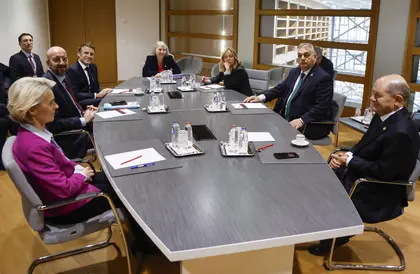On Feb. 1 all 27 EU leaders agreed on vital aid for Ukraine totaling €50 billion ($54 billion) at an extraordinary summit in Brussels. The funding deal is set to cover the period 2024-2027.
A major deal with compromises
JOIN US ON TELEGRAM
Follow our coverage of the war on the @Kyivpost_official.
“We have a deal,” European Council President Charles Michel announced on X, heralding the unanimous decision of EU leaders that ended more than a month of uncertainty due to opposition by Hungary`s Prime Minister Viktor Orban.
Agreement was reached “quickly,” as Orban finally succumbed to pressure following a series of meetings with the Italian, French and German leaders, along with the EU leadership, just before the summit, Michel’s spokesperson confirmed.
However, there were compromises. In two years, there may be a European Commission proposal to review the funding agreement in the context of EU budget arrangements.
Orban also declared “mission accomplished,” with Budapest given a guarantee that the European Commission will evaluate the rule of law in Hungary fairly and objectively.
First tranche of funding set for March
Shortly after the EU’s decision, Ukraine`s Ministry of Economy released a statement that Kyiv “expects to receive the first tranche of €4.5 billion in March.”
In late February, the €50 billion aid agreement must pass through the European Parliament so that MEPs can check all the details carefully.

Ukraine’s Navy Shoots Down Russian Missile – A New Air Defense Strategy?
“EU leaders just approved an idea without any technical details, and the adoption [of financial aid for Ukraine] will be in late February,” Roksolana Pidlasa, head of the budget committee of Ukraine's parliament told Kyiv Post.
According to Pidlasa, no difficulties are expected with the aid package.
Kyiv expects to receive €18 billion during 2024
“The Ukrainian government is holding negotiations [with EU representatives], and we have cautious optimism that the first €18 billion will be provided to Ukraine in 2024,” Pidlasa said.
The sum is important for Ukraine to top up its budget deficit, after setting aside $47 billion (22 percent of the country’s GDP) for defense spending. This year's social spending alone amounts to Hr.469 billion ($12.5 billion), equating to about a quarter of the €50 billion aid amount.
“Only €39 billion (or about 75 percent) of the €50 billion will be directed to the national budget as direct budget aid. This money will go to the budget’s general fund and will be used as in the previous year for various social and humanitarian spending: pensions, social payments, salaries for doctors and teachers,” Pidlasa explained.
She added that Ukraine may have some recommendations for the European Commission on certain needs which should be covered by this money.
The small print
In summer 2023, the European Commission proposed a new investment plan, the Ukraine Facility, to provide predictable financial support for Ukraine over the 2024-2027 period. The Facility aims “to cater both for short-term State and recovery needs and the medium-term reconstruction and modernisation of Ukraine.”
A draft of the Plan was approved by Ukraine's government late last year, with the European Commission subsequently able to provide its suggestions, including final conditions and a tranche schedule.
The Ukraine Facility makes it clear that EU aid will be provided to Ukraine in the form of grants and loans.
According to European Commission Q&A, the facility is “aiming to provide at least €2.5 billion as an annual indicative amount [that] will cater for the grant part as well as provisioning for guarantees.”
Pidlasa confirmed that the main body of the €50 billion aid amount to Ukraine will be in the form of loans.
“At the same time, the EU provides us with non-refundable aid [grants] to cover interest on the loans. So the money is free for use, but will have to be returned,” the head of the budget committee said. She added that Kyiv will return all of the €50 billion aid.
You can also highlight the text and press Ctrl + Enter










